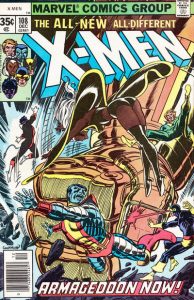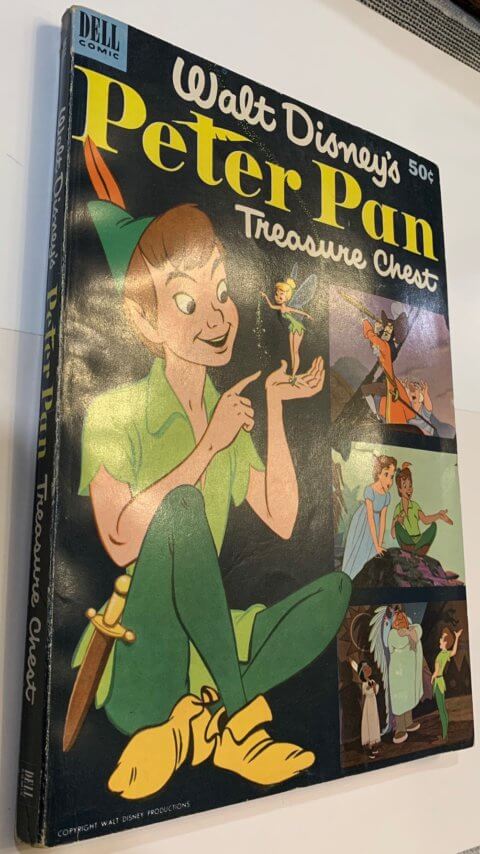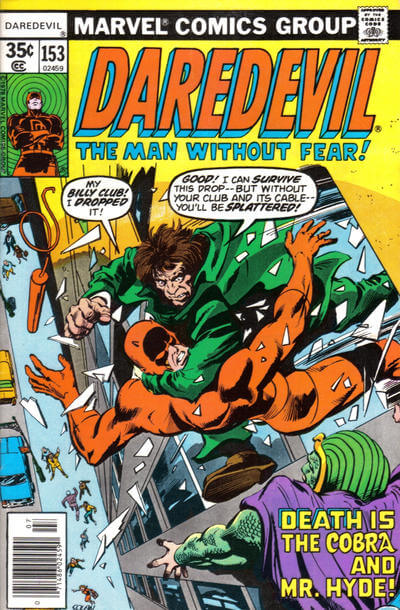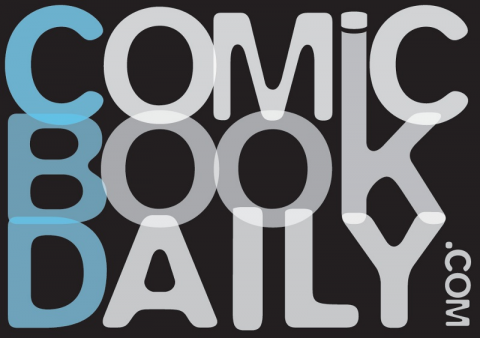 X-Men #108, Marvel Comics, December 1977.
X-Men #108, Marvel Comics, December 1977.
Earlier today I read Dennis DePues’ post on the great John Byrne coming to this year’s Fan Expo in Toronto. It got me thinking of a few Byrne I have on my potential future Spotlight list so I took the cue (my wife made me read Celestine Prophecy years ago) and tried to narrow down my picks to one. High on my list were Giant Size Dracula #5 (Byrne’s 1st Marvel work) and Marvel Team-Up #53 (Byrne’s 1st X-Men work) but after a few sips of club soda I decided this week’s Undervalued Spotlight should be X-Men #108.
It doesn’t hurt that X-Men #108 is embedded in one of the most collected runs in the hobby, X-Men #94 to #143.
X-Men #108 is the start of the John Byrne run on X-Men and historically speaking it’s a big book. I can’t add anything new to all that has been written about the importance of the John Byrne, Chris Claremont and Terry Austin run on X-Men, all I can do is agree that this creative team may very well have saved the medium.
With so much focus on 1st appearances and covers in the current back issue market I’m betting that soon enough a pivotal issue like X-Men #108 will garner the demand it deserves. The book belongs in any collection with a focus on books that signaled a change in the course of the medium, I’d put it in a box with Amazing Spider-Man #96, Detective Comics #395 and Daredevil #158. All must have’s for reasons other than 1st appearances or covers, all influential well beyond their immediate impact.
So John Byrne helped save comics with his commitment to Wolverine and the rest of the X-Men but the man didn’t stop there, he moved on to an epic and era defining run on the Fantastic Four and then made great contributions to a tired and staid Superman.
Reading Dennis’s post made me realize that time has past and that Byrne, ever the current an contemporary as I was making my journey through comics, has moved on into the realm of legend, he is indeed now one of the giants.
The back issue market is indifferent to X-Men #108, CGC 9.4 copies sell below the 9.2 Guide price. The book is sought after because it’s Byrne’s jump on point but it’s obvious the significance of the event has not been fully embraced by the market, yet.
The 47th Overstreet price break for this book is $49/$92/$135 in the 8.0/9.0/9.2 grade splits.
Reasons to buy this comic book as an investment:
- John Byrne begins his X-Men run
- A pivotal book, an important marker in comics
- Embedded in the iconic and highly collected X-Men #94 to 143 run




I own a beat-up copy of Nightmare #20.
Walt, you don’t have to convince me on this one. For personal reasons I would put this book in my top five. I can remember where and when I bought this book on the newstand, and I’ll indulge myself by relating.
In the summer of 1977, I was at the beach with my family for two weeks, which meant daily visits to the 5&10 to examine and reexamine the spinner racks. New books arrived mid-week, so this meant three chances to see something new: upon our arrival on the weekend, the middle of that week, and the middle of the following week. I didn’t read a lot of Marvel titles at that point, and I knew nothing about the X-Men revival when we arrived, but my first purchase was a fairly stale Iron Fist #15. This book was double-barreled – new characters (these were X-Men?) and great art – I read and re-read it, and I was really looking forward to #16 (I still am).
Later in the vacation, X-Men #107 appeared on the rack and the cover blew me away. I had seen a few of these X-Men, but this was a whole different level. As happened less often than not, the interior matched the cover, and I was hooked. So X-Men #107 is also in the top five. But while I loved the story and the bazillion characters, in some ways the art just wasn’t what I was looking for after Iron Fist #15.
Recall that X-Men was bimonthly at this point, so this meant a long wait after vacation for the next issue. When #108 did arrive at my usual haunt, the cover was in line with what I expected, but when I opened the book – well, I can’t say the scales immediately fell from my eyes, but it was close. At that point I was a big Adams aficionado, but he was boycotting the big publishers, and really nothing I had been reading came anywhere close to his work. Until #108. THIS was what I wanted in comic book art! In some ways superior (dare I say) to Adams, whose exquisitely detailed and creative compositions could distract one from the story line. This art told the story without overpowering it, and yet displayed a unique beauty and talent that I didn’t see in any other comic art at that time. I took note of the name. From that day forward (until the mid-eighties), if Byrne drew it, I bought it. (And full recognition to Terry Austin, who was the jelly to Byrne’s peanut butter just like Giordano was for Adams.)
That’s the story on #108, but I’ll relate one further fortunate follow-on. The next summer I was back at the beach, and my love of Byrne’s art was in full bloom. X-Men #113 arrived, and I devoured it (the cover is one of my favorites of all time). The next day I went back to the store, vainly looking for #114, but of course knowing that I wouldn’t see it for a month (thankfully according to #113, “NOW ON SALE MONTHLY!”). This was my drug, and I needed more NOW. There was only one thing to do: I bought more copies of #113. I decided then that Byrne was so good that not only would I buy everything by him, but whenever possible I would buy three or more copies for posterity. It turns out this was a good decision, which would been vastly better if I had vowed to buy only the best available copies, store them in two mil mylar bags with a sheet of microchamber paper, and keep all copies in a climate-controlled facility (not really in my thirteen-year-old’s budget).
So in your usual sense of “undervalued” – how can something priceless _not_ be undervalued?
Nevertheless I will come down to earth and ask: is it under_priced_? I took pretty good care of my first #108, but that means it’s probably something like a 7.0. Later I bought another copy at a show – let’s say that one is a 9.0. Given what this book means to me, I’ve toyed with the idea of buying a 9.8. But as I have my “original owner” copy, it’s hard for me to ascribe outsize value to somebody else’s perfect copy, so I have stayed away to this point because I haven’t seen a compelling investment argument. While this book means a lot to me, you, and many others as either/both a personal milestone and milestone for the hobby, unfortunately that doesn’t seem to be enough for the majority of players. I think this is driven by various factors:
– You have to be of a certain age to remember when this book came out and what it meant.
– Overall “first” artist work of one kind or another doesn’t mean much to the community. (My long-shot bet on this turning around is Catman #8.)
– For whatever reason Byrne art isn’t prized the way it seemingly should be. I think this is mainly due to his prodigious output and basically defining a new standard. Kirby of course in the same boat. At the risk of inciting ire, I have to shake my head whenever I see some recent J. Scott Campbell cover selling for big numbers – but of course I feel the same way about the crazy prices for meaningless (my word) mid-grade GGA golden age covers these days.
– This is an interior art transition – the cover is Cockrum. Insult to injury.
I think that’s enough to call into question expecting this to become a “hot” book any time soon. Adding to the negatives is that this appears to be a relatively plentiful issue in high grade, in extreme contrast to #107, of which there are only 24 9.8s, one selling last year for $3800. If you take the last sale price of a 9.8 #108 of $525 and adjust for population, #108 is about half the value of #107, which has the first full Starjammers appearance.
So my call is – not underpriced in the current market. Therefore this is a long-term investment candidate based on an expectation that the hobby deepens, and these key events in the history of comics achieve higher recognition than they currently receive. Personally I am inclined to this approach, but I have to admit that I am becoming despondent when I see a mid-grade Jetta or off-off-brand publisher zombie book selling for four figures. The way these buyers ascribe value is beyond me at this point.
And finally – if you are in, you have to go all in. Get a perfect 9.8 and don’t think about downgrading it until the current market price moves above $2000.
It certainly was a magic time for me after what felt like a long drought in the Bronze Age of a run of steller stories and characters.This was the total package.Great pic Walter!
Another epic critique Chris – thanks.
I agree that a 9.8 is the way to go but make it the best 9.8 possible – must have white pages,, must be dead square, not underbound, not overbound, nice and tight with high gloss!